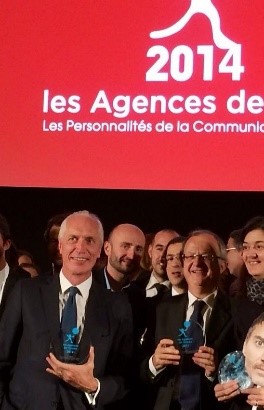
The future of our profession.
For once, “Notre Regard Sur” will focus on… our own news and on the Agency of the Year Award 2014 that CLAI received on December 9. We owe this award above all to our clients, who have placed their trust in us year after year, but also, one might assume, to our perception of the profession and our ability to anticipate its changes.
In order to respond to the new communication issues facing the companies and institutions that call on our expertise, we never stop wondering: which direction will communication take in the years to come? We are constantly analyzing its evolutions to try to understand the consequences.
One of the main changes is obviously the inflation of new media (expansion of social networks, blogs, ultra-specialized media, etc.) which gives each citizen a new power: producing, influencing, and competing with information professionals. With its corollary, the liberation of speech: anyone can condemn or testify using links, tweets, likes. The speed of information then takes the lead over the accuracy of facts, virality over the veracity of the words. It is the pace of the internet and the instantaneousness of social networks that now structure what was not so long ago called information.
This disruption of media reporting is coupled with an escalation of sensitive situations for companies. Difficulties can no longer remain internal; the slightest tension or discrepancy can be put on the public stage: transparency is no longer a choice. Among many examples, the espionage of Ikea employees revealed by the Canard Enchainé, the exposure of false testimonies of an Accor manager towards his competitors on TripAdvisor, etc.
We also note that external risks are taking new forms: criminal behavior – industrial espionage, data theft, hacking, etc. – for which few companies are prepared. “Citizen” or even individual attacks, via employees who call themselves “whistleblowers”, are replacing or adding to the traditional frontal attacks: strikes, social conflicts, petitions, or open letters. Destabilization strategies are more insidious, more dispersed, and more viral. The hijacking of brands is a perfect example: remember Findus, which was mocked on the web following the horsemeat affair.
The introduction of “class action” into French law (by the Hamon law on consumption, adopted in February 2014) will also change the way companies manage their relations with consumers and with their other stakeholders. It is likely that they will also have to deal with activist groups, at least as powerful than them, when it comes to media exposure, as in the case of the “Zadistes” protest movement against major development projects.
At CLAI, we firmly believe that instead of fearing these developments, 21st-century communication must draw its new forms of intervention from them. Social networks must be the tool of a new development axis based on co-construction: the company will design its products and even its services by gathering the views of its audiences. This is already the case for instance for luggage manufacturer Delsey, which is refining the features of its suitcase by asking consumers to vote on a dedicated website.
In the same way, “gamification” and “entertainment” will make it possible to convey a positive image, provide an original experience and increase the visibility of companies or their brands through the virality that online games can offer.
The company will also have to know how to leverage current events, to carry out “newsjacking” operations. This is what the company Motoblouz did when it was able to leverage the Hollande/Gayet affair by humorously thanking the President for having used one of its scooter helmets. It will rely on “brand content” to allow brands to emerge on the web, to exist in the public space: as Leroy-Merlin did with its daily “Du côté de chez vous”, or as Michel-Edouard Leclerc, who managed to make the retailer disappearing behind the purchasing power activist with his “blog” quiestlemoinscher.com. Playing between the lines of communication and advertising, brands will produce their own “media” content. Finally, to keep up with the times, the company will have no other choice to put forward its social utility and promote a responsible activity: Monoprix, which has already understood this crucial issue, has launched a campaign to fight against food waste.
The deployment of these new strategies will require a different structure for the communication departments. They will be organized into ‘newsrooms’, having the capacity of monitoring and strategic planning as well as preparing content in real-time. They will operate with deadlines close to immediacy. Writing, filming, posting, and (re)tweeting will become basic skills. Profiles will have to be transformed under the sign of diversity.
Siloed organizations will be weakened and will lose ground to those that are more flexible and cooperative. Doubts, hesitations, and slow decision-making will be a handicap.
Our daily objective is to help our clients master this triptych, speed, content production, and truthfulness of speech, which must form the basis on which they can build a rich and lasting relationship with their audiences.
